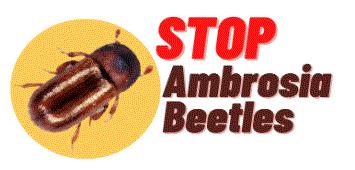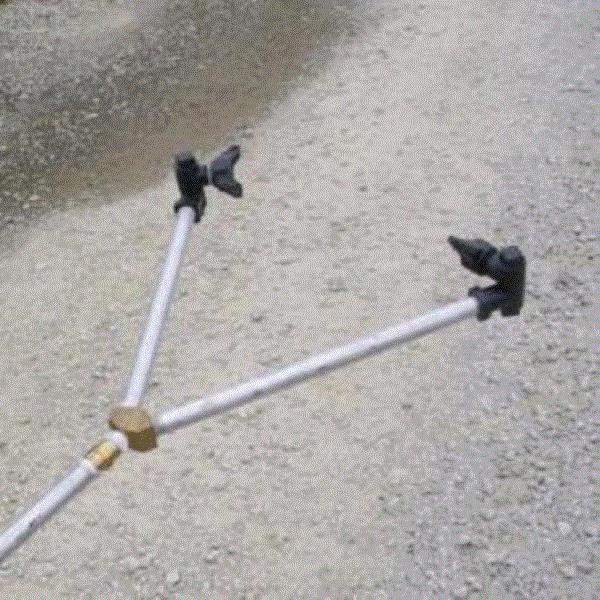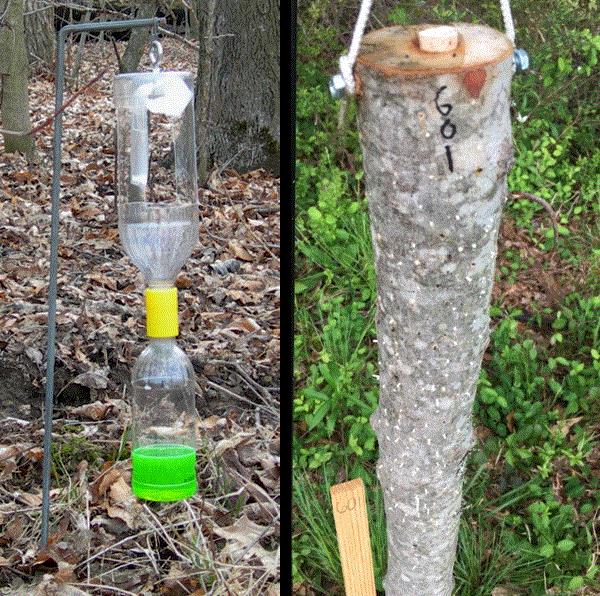Are Ambrosia Beetles Bugging You?
I wanted to have a cutesy subject line, such as “A is for ambrosia beetles,” to get your attention. Then I remembered my youngest’s face and him joking (not about this newsletter, but about a gift from my lovely wife—a mouse pad with her dog Whisky’s face printed on it), “That’s just the nerdiest thing!”
Self-consciousness drove me to tune it down a little. (Despite my apparent shamelessness, I’m actually quite thin-skinned, believe it or not.)
So spring is for ambrosia beetles.
And it’s no joke or anything nerdy about it. After working with ambrosia beetles for more than a decade, I’ve developed a habit of telling folks to watch for ambrosia beetles as soon as February comes to an end.
Why? Ambrosia beetle isn’t a concern for y’all who work in a greenhouse. For those who produce and sell containerized or field-grown trees or manage trees in landscapes, ambrosia beetles can become a problem. Ambrosia beetle attacks are death sentences for trees grown in nurseries; established trees in the landscape can sometimes survive attacks, but they aren’t the same anymore.
I conducted a survey of North Carolinian growers (with help from Danny Lauderdale of North Carolina State University Extension) in 2020. We found that 26% of growers suffered attacks every year and 83% of those attacks occurred in February through May. Of those reported the amount of crop losses, 44% lost more than $1,000 worth of trees and 50% spent more than $1,000 in management every year. Doesn’t sound like much, right? But every $1,000 adds up over a three-year crop cycle. Some nurseries lost and spent more than that.
In 2021, I was lucky enough to join a project funded by a major grant from the U.S. Department of Agriculture’s (USDA) Specialty Crop Research Initiative (SCRI). Now we have enough money to hire staff, students and post-doctoral researchers to work on understanding ambrosia beetles and improving their management in ornamental tree, fruit and nut production systems. We have entomologists, horticulturists, plant pathologists, economists and other professionals working on this project throughout the country.

I think we’ve found out quite a bit about ambrosia beetles. I can now tell you what to do about them instead of just reminding you to monitor them in the spring. So I’m going to use this week’s issue to introduce some major findings of the projects that you can use in your operations today. Let’s get “boring” together.
Go to the project’s website, Stop Ambrosia Beetles, to find more information about this project, or results and resources from this project.

Which is More Attack-Inducing: Flood or Drought?
We’d known for a while that flooded or overly wet potting media induces ambrosia beetle attacks in the spring. A series of experiments, led by Chris Ranger of USDA-ARS and the head honcho of the Stop Ambrosia Beetles project, have established the connections between an increased production of ethanol by flooded trees and an increased attraction (by ethanol) and attacks by ambrosia beetles.
What’s not clear is the influence of drought stress. Can drought, which also imposes stress on trees, also induce attacks?
Chris and a group of colleagues from USDA-ARS, Tennessee State University and NC State University answered that question with a study published in the scientific journal Frontiers in Insect Science in July 2023.
In two experiments conducted in 2016 and 2020, containerized flowering dogwoods (which is highly susceptible to ambrosia beetle attacks) were flooded (root balls were continuously submerged in water), drought-stressed (irrigation water and rainfall prevented by placing barriers on top of the pots) and irrigated as usual. The team then counted how many ambrosia beetles landed on the stems and how many bored in.
The team found that beetles were attracted to and attacked the flooded trees three to five days after flooding. No drought-stressed or standard-irrigated trees were attacked. Ethanol was detected in the plant tissues from the flood-stressed treatment, but not from the drought-stressed or standard-irrigated treatments. So, once again, flooded trees are shown to produce ethanol and are more susceptible to ambrosia beetles. Drought doesn’t induce attacks.

Flood can make some intolerant species, such as this flowering dogwood, more susceptible to ambrosia beetle attacks. A frass tube created by an ambrosia beetle is circled. (Photo credit: JC Chong.)
One thing I need to add—the flood/ethanol/attack relationship is likely different among tree species. Flowering dogwood is a notorious hater of wet feet. An earlier study showed that flood-intolerant species—such as dogwood, redbud and styrax—were stressed by flood to a greater degree, produced more ethanol and were more frequently attacked by ambrosia beetles than other flood-tolerant species, such as silver maple, river birch, American elm and swamp white oak. Go HERE for this paper.
Similarly, tree species that are more intolerant of drought will likely be more susceptible to ambrosia beetles when exposed to prolonged drought. The key word here is "prolonged." In this experiment, trees were drought stressed for only 14 days. What will happen when trees are exposed to drought for months? Experience in the western United States indicates that trees stressed by prolonged drought are more susceptible to bark beetle attacks.
It'll be difficult to do something to prevent stress or know if a tree is stressed. After all, a tree won't tell you it’s stressed; it may be too late when symptoms appear. There are planting practices we can do to avoid stressful conditions. The concept of “right plant, right place” applies not only to landscape plantings, but also in nurseries. Flood-intolerant species are best not planted where it’ll flood for a few days or weeks.

Which Insecticide is the Silver Bulltet?
Since there’s no viable proactive approach to prevent stress and attraction, we resort to spraying insecticides to prevent attacks by ambrosia beetles. I dare say more than 90% of growers spray a pyrethroid, with bifenthrin and permethrin being the most commonly used. Others use carbaryl or chlorpyrifos.
One of the goals of the Stop Ambrosia Beetles project is to reduce the use of pyrethroids and other broad-spectrum insecticides. We wonder if other insecticides can replace pyrethroids, carbamates and organophosphates in dealing with ambrosia beetles.
We tested a range of different products on ornamental trees, pecans and apples since 2022—acetamiprid, cyantraniliprole, cyclaniliprole, indoxacarb, plinazolin, spinosad, spinetoram + sulfoxaflor, tetraniliprole, tolfenpyrad, Beauveria bassiana, Burkholderia, Chromabacterium subtsugae and Isaria fumosorosea. Unfortunately, these insecticides—along with carbaryl, cypermethrin and deltamethrin—weren’t as effective as bifenthrin or permethrin in preventing attacks. We’d failed to find a viable replacement for pyrethroids and carbaryl.

A modified spray wand like this directs good spray coverage to the trunk, which is the part of a tree that needs to be protected from ambrosia beetle. Go HERE for an article on the benefits of this spray wand compared to an airblast sprayer. (Photo credit: Steven Frank, NC State University.)
What about drenching with a systemic insecticide, you ask? We’d tried that many times in the past and didn’t achieve any efficacy. Drenching and imputing plant tissues with systemic insecticides couldn’t prevent attacks (because it didn’t prevent ethanol release or lay down a residual layer on the stem surface) or kill the beetles that had bored into the stems (the adults and larvae didn’t ingest the treated tissues and the larvae only feed on the symbiotic fungi).
The key objective of spraying against ambrosia beetles is to prevent boring activity. Ambrosia beetles carry with them the symbiotic fungi that their larvae feed on; the fungi also causes tree diseases and death. The fungal spores are deposited as the beetles bore into the wood, so it’s already too late in preventing potential tree death by the time the beetles attack. The success of a management program should be to prevent boring; systemic insecticides fail to do so.
Since tree death is caused by the symbiotic fungi, why not treat the plants with a systemic fungicide and kill the fungi? That way you can save the attacked trees. It’s too early to generate any recommendation because there's too much conflicting information from our experience and previous studies. In my experiment, drenching and trunk spraying with thiophanate-methyl didn’t reduce ambrosia beetle attacks and prevent unflooded redbud tree death.
In another study, trunk sprays of azoxystrobin and potassium phosphite didn’t prevent attacks, but reduced infection in flooded redbud trees. In yet another study, flooded redbud and tulip poplar trees sprenched with pyraclostrobin + boscalid suffered fewer attacks when the trees weren't inoculated with phytophthora. The protection of the fungicide was reduced in trees inoculated with phytophthora.
A recent study reported spraying and drenching flooded flowering dogwood trees with acibenzolar-S-methyl reduced ambrosia beetle attacks. (As far as I know, acibenzolar-S-methyl or Actigard isn’t currently registered for use on ornamental trees.) None of these studies really provide a good explanation about the mechanisms of these fungicides. There's quite a bit of interplay among fungicides, symbiotic fungi and ambrosia beetles that we still don’t know about.
For now, our chemical management approach is stuck on spraying pyrethroids when the ambrosia beetles are flying in the spring. Again, the key is to prevent boring, so the insecticides must be applied before the beetles attack. Application also needs to be repeated every 10 to 14 days to maintain maximum repellency against the beetles.

How to Set Up a Monitoring System
Knowing when the beetles become active is important because insecticides must be applied before the beetles attack. That means we need a useful monitoring system.
How beneficial is a monitoring program? Let me give you an example: A nursery in South Carolina reduced ambrosia beetle attacks from 13% to 1.3% in the first season of adopting a soda bottle monitoring program. Every dollar spent on setting up the traps, monitoring and spraying saved $20 in damage.
A soda bottle trap is pretty easy to make. You need an empty 2-liter soda bottle. Cut windows into the bottle. Then you connect the soda bottle to a smaller bottle with a Tornado tube (or a section of hose or any other way you can think of). You hang a commercial ethanol lure (or a pill bottle filled with ethanol and a wick) in the soda bottle, and some soapy water or antifreeze, and voilá! A soda bottle trap. You hang the traps along the edge of the nursery and wood lots before beetles are expected to fly. (See the next section on determining when the beetles are expected to fly.)
The soda bottle trap is old school. It’s cheap and easy to make, but it captures just about any species of ambrosia beetles that come by for a visit, so it’s not precisely targeting the three to four species we're most concerned with.
Also, a soda bottle trap can catch hundreds of beetles of all different species on a good day. You need to pour them out of the small bottle, rinse the antifreeze of soapy water off the captured beetles, and spend the time to sort through them to identify the species we're concerned with.
Finally, the soda bottle trap tells you when the beetles are flying, but not if the beetles are attacking. You want to prevent attack, not prevent flying, so applications against flying are premature and wasteful.

A soda bottle trap (left) and a bolt trap (right) used for monitoring ambrosia beetle activities. (Photo credit: Chris Ranger, USDA-ARS; Shimat Joseph, University of Georgia.)
Here's a better monitoring system: the wood bolt system!
It’s just as easy to make. You cut a section of live wood from any smooth-bark tree species (about 10 to 12 in. in length and 2 to 3 in. in diameter). Then drill a hole, about 4 in. in depth and a third or a quarter of the diameter of the bolt. Fill the hole with ethanol, cap it with a cork stopper and hang it up along the wood line just like a soda bottle trap.
I think the wood bolt system is better than the soda bottle trap for two reasons: one, only the species of concern attacks the bolts. And secondly, the species attacks only when they're ready to attack. So the wood bolt system is more precise both in terms of species of concern and their attack timing.
Some growers complained that it’s a bit troublesome to drill a hole in the bolts. In the Stop Ambrosia Beetles project, we found that bolts soaked in ethanol for 24 hours were better than bolts filled with ethanol in attracting beetles, so now you don’t have to drill a hole in the bolts. Just put the bolts in a Ziplock bag, cover the bolts with ethanol, then let them soak for a day. Easier!
What about ethanol? I've always used 75% ethanol, but most growers have a hard time finding ethanol of high concentration. We ran an experiment and found that bolts filled with 30% ethanol were as effective in attracting beetles as 60% or 90%. So you can just fill or soak the bolts with the cheapest, nastiest moonshine or vodka (which is 40% ethanol). Easier!
Which tree species should I use to make the bolts, you ask? Well, I had the same question for a very long time. When the market wasn’t this hot, I could cut as many dogwoods, redbuds, tulip poplars, red maples or southern magnolia from nurseries as I wanted. But now? Good luck if I don’t get kicked out of the nursery when I show up with a chainsaw. So if I want to replace redbud or another tree species, I typically use one that’s widely available to me.
I ran an experiment to see which tree species grow in my woods—sweetgum (the upper, smooth-bark portion of the tree), tulip poplar, American holly, red maple, southern magnolia, horsesugar, hickory, water oak, black cherry, wax myrtle and redbud—all of these can be used to make bolts. I also threw in three invasive species—callery pear, mimosa and Chinese privet, thinking that I’ll give them so purpose on my land. I made bolts from the selected tree species, filled them with ethanol and hung them up.
The most heavily attacked species were sweetgum, tulip poplar, horsesugar, wax myrtle and mimosa in 2022, and tulip poplar, horsesugar and water oak in 2023. Other than tulip poplar and horsesugar, results from the other species weren’t consistent. I’ll run a third try this spring to see if I can find some kind of conclusion. One thing to note is that all the tree species tested were attacked, so all of them can be used to make bolts for monitoring. I say, let’s just use any smooth, thin-bark tree species you can find for making bolts.

What About Degree-Day & Plant Phenological Indicator Models?
Back to the issue of knowing when the beetles are flying so treatments can be applied on time ... I don’t understand why, but some of y’all may still find soaking bolts or setting up soda bottle traps to be too much trouble. Folks often ask me if we can simply time insecticide treatments to growing degree days or plant phenology. (I supposed I should be happy that these folks don’t just spray by calendar.)
Jason Oliver and his team at Tennessee State University summarized years of trapping data in a poster presented at the annual meeting of the Entomological Society of America last November. Jason and his team reported that the emergence of granulate ambrosia beetle is typically proceeded by two to three consecutive days of above 70F maximum air temperatures and average air temperatures approaching 65F. Black stem borer emergence requires fewer consecutive days above 70F, so they typically emerge earlier than the granulate ambrosia beetle. The first and peak blooms of eastern redbud coincide, imperfectly, with the average flight of granulate ambrosia beetle and black stem borer.
Again, I think flying beetles aren't necessarily attacking beetles, so I still recommend that y’all set up bolts to determine precisely when the beetles attack.

We're Ready to Help!
I've only scratched the surface of what we know about monitoring and managing ambrosia beetles in this newsletter. More information is curated at the Stop Ambrosia Beetles website and additional information will be added as the research teams completes the experiments.
Want more information or see if someone can give a talk at your local educational event or annual meetings? Just reach out to me or Chris Ranger, the project director of Stop Ambrosia Beetles. We're ready to help you reduce your ambrosia beetle issues this spring!
See y'all next time!

JC Chong
Technical Development Manager at SePRO
Adjunct Professor at Clemson University
This e-mail received by 27,847 subscribers like you!
If you're interested in advertising on PestTalks contact Kim Brown ASAP!